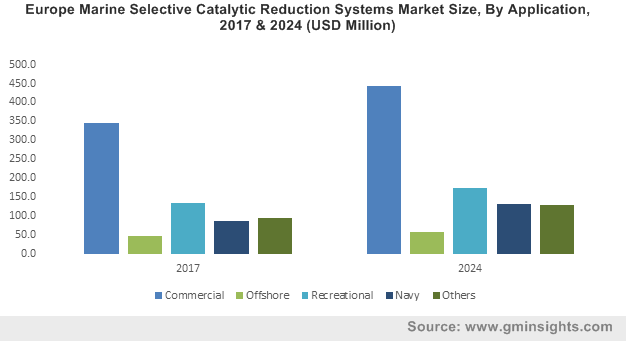Marine selective catalytic reduction system market to accumulate substantial gains from commercial applications, global industry valuation to hit the 5-billion-dollar mark by 2024
Publisher : Fractovia | Published Date : October 2018Request Sample
Growing environmental concerns have gradually led to the expansion of marine selective catalytic reduction system market, fostered by the mandates issued by international agencies and the willingness of shipowners to adopt emission control systems. Stricter adherence to emission norms in the Emission Control Areas (ECAs) and increasing awareness of the need for protecting marine as well as human life has encouraged efforts to curb maritime pollution. Amassing revenues of over USD 3 billion in 2017, the marine selective catalytic reduction system industry has seen accelerated growth in the last few years owing to International Maritime Organization's (IMO) Tier 3 regulations introduced in 2016. Tier 3 is a more stringent regulation which requires 80% NOx reductions relative to Tier 1, leading shipping companies to turn towards the marine selective catalytic reduction system market.
Europe Marine Selective Catalytic Reduction Systems Market Size, By Application, 2017 & 2024 (USD Million)

Essentially, selective catalytic reduction (SCR) is able to operate as a standalone system for reducing NOx by 80% or above and was already being widely used on land for its high durability and reliability. Commercial marine industry is known as the backbone of international trade but is also responsible for a major chunk of emissions, becoming a key target base for the global marine selective catalytic reduction system market. As of January 2017, there were more than 50,000 merchant ships transporting every kind of cargo around the world, operated by over a million personnel, belonging to almost every nationality, who are exposed to harmful diesel emissions. Apparently, in 2011 it was determined that smokestack emissions from international shipping was responsible for killing nearly fifty thousand people in Europe every year.
Subsequent policies developed and enforced by governments worldwide has boosted the marine selective catalytic reduction system market earnings, which is expected to show a continuous rise with the rising demand for commercial freight. Increased disposable incomes have not only thrusted the demand for international goods, but also developed a penchant for luxury and tourism services among the world’s population. As such, cruise shipping companies have ordered record number of ships to be built over the coming years and prominent cruise lines would have more than 50 new ships entering into service by 2027. Growing fleet size of cruise lines, in conjunction with the imposed emission targets, will significantly propel the marine selective catalytic reduction system industry from commercial applications. Indeed, marine selective catalytic reduction system market from commercial applications is expected to depict a CAGR of 2% over 2018-2024.
Rising exports of resources such as oil will strengthen the international shipping industry, which accounts for over 90% of the carriage globally. Countries expanding their oil producing capacity will elevate global exports and the U.S. is one such nation, which is soon expected to become a net exporter of oil. It has been forecasted that by 2022, the energy exports of U.S. will surpass its imports, indicating the tremendous growth of commercial shipping from the region and a prolific future for the marine selective catalytic reduction system market. Experts believe that majority of crude coming from U.S. would be directed towards Europe and Asia, emphasizing the development potential of the global commercial tanker fleet.
Rapid urbanization across the world has augmented the demand for building materials and stimulated the production and export of cement. Signifying a major leap for the marine selective catalytic reduction system industry, the cement carrier NACC Alicudi became the first of its kind in 2017 to be equipped with IMO Tier 3 compliant diesel engine. Boasting of the world’s fist Scania Tier III diesel engines, developed jointly by Van Aalst from Netherlands and Scania from Sweden, the carrier has Scania SCR system to lower its emissions. NACC Alicudi has entered into a three-year contract on the east coast of Canada and U.S., which has been declared as NOx ECA for newly built vessels, since it is now compliant with IMO regulations.
As more commercial shipping companies transition to engines with SCR systems for being IMO compliant and operate in ECA zones, the global marine selective catalytic reduction system market is anticipated to register gains of more than USD 5 billion by 2024. Caterpillar, Wärtsilä, MAN Energy Solutions, Johnson Matthey, PANASIA, Danish Technology, Agriemach and Mitsubishi are some prominent names constituting the competitive hierarchy of marine selective catalytic reduction system industry.